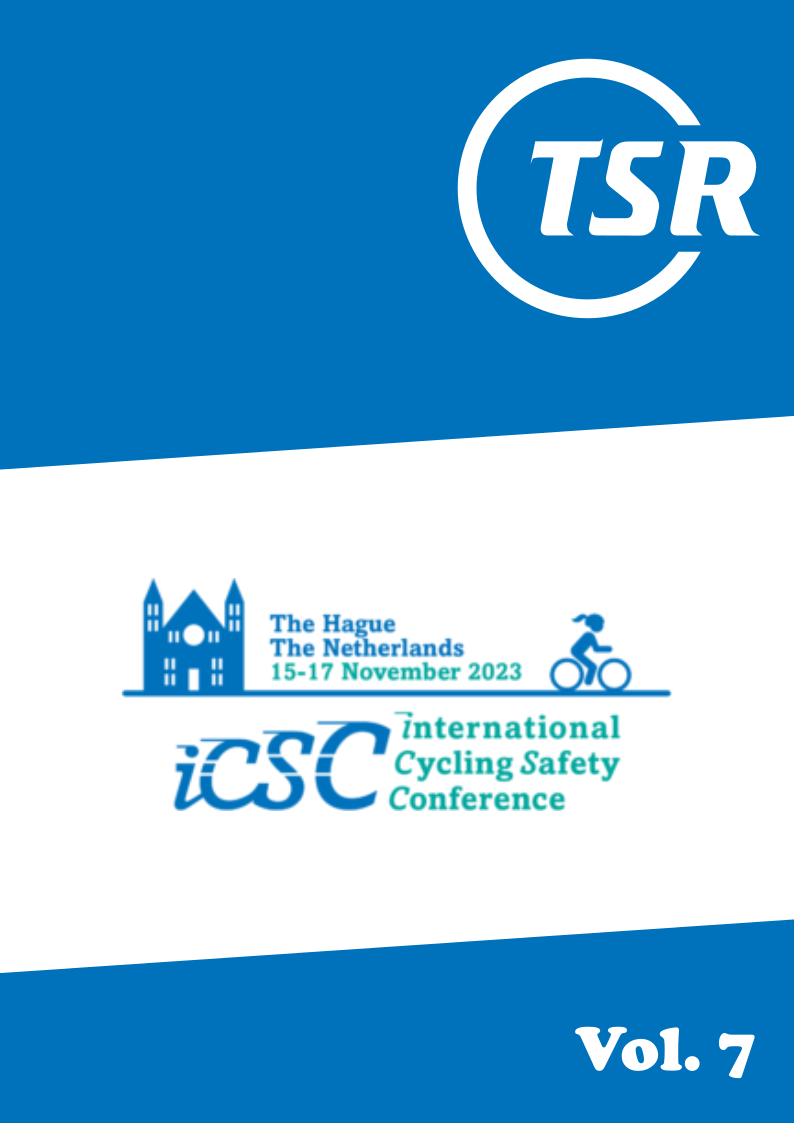Determinants of cyclists' willingness to comply with mixed traffic provision and to ride on the carriageway rather than the pavement
DOI:
https://doi.org/10.55329/bwaa1131Keywords:
binary logistic regression, cycling provision, shared lane markings, speed limitAbstract
Stakeholders in many municipalities worldwide are committed to promoting cycling and improving cycling provision. Scarcity of space is a major issue in most of these cities, particularly for main streets with significant movement and place functions. Multiple demands exist on these streets, including moving pedestrians, cyclists, motorised vehicles, parking, people waiting at public transport stops, or staying in the street for place activities. Mixing cyclists and motorised vehicles in the same space in the carriageway might be the only possible solution for cycling provision in these contexts, which is applied in many German cities. The aim of this study is to evaluate the acceptance of cycling in mixed traffic, which we measure as the proportion of cyclists riding on the carriageway versus on the pavement. The empirical work in this study is based on video observations at 273 study sites with a total length of 124 km located in 13 cities in Germany. 260 of these study sites have no marking for cyclists, and 13 have bicycle pictograms. A total of 34 874 cyclists are recorded at these study sites. A logistic regression model is used to quantify the effect of exposure and infrastructure characteristics on the proportion of cyclists on the carriageway. Volumes of motorised vehicles, lane widths > 3.00 m and city type show a significant negative effect on the acceptance of cycling on the carriageway. Cyclist volumes, bicycle pictograms, and a speed limit < 50 km/h significantly increase the likelihood of cycling on the carriageway. The model is then applied to develop evidence-based recommendations on appropriate conditions for mixed traffic provision for cyclists, ensuring pre-defined levels of acceptability. Cycling in mixed traffic without bicycle pictograms should only be recommended with traffic volumes of a maximum of 400 vehicles per hour and a speed limit of < 50 km/h to achieve a proportion of cyclists on the carriageway of 90%. The marking of bicycle pictograms increases acceptance.
Downloads
References
AASHTO, (2012), Guide for the Development of Bicycle Facilities, (Washington, US: American Association of State Highway and Transportation Officials).
Alrutz, D., W. Bohle, R. Maier, M. Enke, M. Pohle, F. Zimmermann, J. Ortlepp, M. Schreiber (2015), 'Einfluss von Radverkehrsaufkommen und Radverkehrsinfrastruktur auf das Unfallgeschehen [Influence of bicycle traffic volume and bicycle infrastructure on accidents]', Unfallforschung der Versicherer, Forschungsbericht Nr. 29.
Alrutz, D., W. Bohle, H. Müller, H. Prahlow (2009), 'Unfallrisiko, Konfliktpotenzial und Akzeptanz der Verkehrsregelungen von Fahrradfahrern [Accident risk, conflict potential and acceptance of traffic regulations by cyclists]', BAST, Bericht zum Forschungsprojekt FE 82.262.
Andersen, T., F. Bredal, M. Weinreich, N. Jensen, M. Riisgaard-Dam, M. Kofod Nielsen (2012), 'Collection of cycle concepts 2012', Cycling Embassy of Denmark.
Austroads, (2017), Cycling Aspects of Austroads Guides, (Sydney, Australia: Austroads).
Birk, M., A. Khan, I. Moore, D. Lerch (2004), 'San Francisco's shared lane pavement markings: Improving bicycle safety', San Francisco Department of Parking & Traffic, Final report.
Cerema, (2020), 'Vélos et voitures : séparation ou mixité, les clés pour choisir [Bikes and cars: separation or mix, the keys to choosing]', Cerema.
Chataway, E. S., S. Kaplan, T. A. S. Nielsen, C. G. Prato (2014), 'Safety perceptions and reported behavior related to cycling in mixed traffic: A comparison between Brisbane and Copenhagen', Transportation Research Part F: Traffic Psychology and Behaviour, 23, 32–43. DOI: https://doi.org/10.1016/j.trf.2013.12.021
CROW, (2016), Design Manual for Bicycle Traffic, (Ede, The Netherlands: CROW).
DfT, (2020), Cycle Infrastructure Design, (London, UK: TSO) Local Transport Note 1/20.
Dietiker, J., M. Youssefzadeh, J.-L. Forssard, M. Hackenfort, B. Hebenstreit, H. Jöri, B. Sick, R. Steiner, C von Moos, S. Matthaei, I. Sommer (2012), 'Mehr Sicherheit dank Kernfahrbahnen? [More safety thanks to core carriageways?]', Schweizerische Vereinigung der Verkehrsingenieure und Verkehrsexperten (SVI), Forschungsauftrag SVI2004/053.
Fahrmeir, L., T. Kneib, S. Lang, B. Marx (2013), Regression: Models, Methods and Applications, (Berlin, Heidelberg: Springer). DOI: https://doi.org/10.1007/978-3-642-34333-9
FGSV, (2010), 'Empfehlungen für Radverkehrsanlagen: ERA', FGSV.
FixMyCity, (2020), 'Studie zur subjektiven Sicherheit im Radverkehr—Ergebnisse und Datensatz einer Umfrage mit über 22.000 Teilnehmenden [Study on subjective safety in cycling—results and data set of a survey with over 22.000 participants]', Radwege Check.
FSV, (2014), 'RVS 03.02.13 Merkblatt Radverkehr [RVS 03.02.13 Information sheet on cycling]', FSV.
Gerike, R., J. Gerlach, A. Rau (2011), 'Accessibility standards - discussion of their necessity with the example of the German “Guidelines for integrated network design” (RIN )', in Reggiani, A., K. Button (eds.), Transportation and economic development challenges, (Cheltenham, UK: Edward Elgar). DOI: https://doi.org/10.4337/9780857930637.00012
Gerike, R., S. Hubrich, F. Ließke, S. Wittig, W. Rico (2020), 'Results of "Mobilität in Städten—SrV 2018"', Technical University of Dresden.
Hantschel, S. (2022), 'Einflussfaktoren auf die Akzeptanz und die Verkehrssicherheit des Radverkehrs im Mischverkehr auf innerstädtischen Hauptverkehrsstraßen [Factors influencing the acceptance and road safety of bicycle traffic in mixed traffic on inner-city main roads]', PhD thesis, Fakultät Verkehrswissenschaften ‘Friedrich List’ der Technischen Universität Dresden, Germany.
Huber, S. (2022), 'Analyse des Routenwahlverhaltens von Radfahrenden auf Grundlage GPS-basierter Daten zum real beobachteten Verkehrsverhalten [Analysis of the route selection behavior of cyclists based on GPS-based data on actually observed traffic behavior]', PhD thesis, Fakultät Verkehrswissenschaften ‘Friedrich List’ der Technischen Universität Dresden, Germany.
Hunter, W. W., L. Thomas, R. Srinivasan, C. A. Martell (2010), 'Evaluation of shared lane markings', Federal Highway Administration, FHWA-HRT-10-041.
Hu, Y., C. Shao, S. Wang, H. Sun, P. Sun, Z. Chu (2023), 'Evaluating bicycling environments with trajectory data on shared bikes: A case study of Beijing', Journal of Advanced Transportation, (1) 1–20. DOI: https://doi.org/10.1155/2023/2560780
Kaplan, S., R. Luria, C. G. Prato (2019), 'The relation between cyclists’ perceptions of drivers, self-concepts and their willingness to cycle in mixed traffic', Transportation Research Part F: Traffic Psychology and Behaviour, 62, 45–57. DOI: https://doi.org/10.1016/j.trf.2018.12.011
Kaulen, R., M. Reintjes, C. Dudde (2014), 'Gutachten zum Einsatz und zur Wirkung von einseitigen, alternierenden und beidseitigen Schutzstreifen auf schmalen Fahrbahnen innerorts [Report on the use and effect of one-sided, alternating and two-sided protective strips on narrow roads in urban areas]', AGFK-BW.
Koppers, A., J. Gerlach, T. Leven, S. Ruf, C. Hagemeister (2021), 'Radfahren bei beengten Verhältnissen—Wirkung von Piktogrammen und Hinweisschildern auf Fahrverhalten und Verkehrssicherheit [Cycling in confined spaces—effect of pictograms and information signs on driving behavior and road safety]', Bergische Universität Wuppertal, Technische Universität Dresden.
Leue, A., W. Bouska (2018), StVO Straßenverkehrs-Ordnung [StVO Road Traffic Regulations], (Heidelberg, Germany: C.F. Müller).
Mills, A., J. Loskorn, J. Brady, J. Duthie, R. B. Machemehl (2010), 'Effects of “bicycles may use full lane” signs on bicyclist and motorist behavior along multi-lane facilities', Center for Transportation Research, The University of Texas at Austin.
MTO, (2021), Ontario Traffic Manual (OTM)—Cycling facilities, (St. Catharines, Canada: Ontario Ministry of Transportation).
NACTO, (2014), Urban Bikeway Design Guide, (Washington, US: Island Press).
NPRA, (2013), Sykkelhåndboka [The bicycle manual], ( Lillehammer, Norway: Statens vegvesen).
NTA, (2023), Cycle Design Manual, (Dublin, Ireland: National Transport Authority).
O'Connor, J. P., T. D. Brown (2010), 'Riding with the sharks: Serious leisure cyclist's perceptions of sharing the road with motorists', Journal of Science and Medicine in Sport, 13(1), 53–58. DOI: https://doi.org/10.1016/j.jsams.2008.11.003
Ohm, D., F. Fiedler, F. Zimmermann, T. Kraxenberger, R. Maier, S. Hantschel, M. Otto (2015), 'Führung des Radverkehrs im Mischverkehr auf innerörtlichen Hauptverkehrsstraßen, berichte der Bundesanstalt für Straßenwesen V [Management of bicycle traffic in mixed traffic on inner-city main roads, reports from the Federal Highway Research Institute V]', BAST, Bericht zum Forschungsprojekt: FE 77.0496/2010.
Pearson, L., S. Reeder, B. Beck (2022), 'A mixed-methods exploration of the factors affecting bike riding participation in Victoria, Australia', International Cycling Safety Conference (ICSC), Dresden, Germany, 8–10 November.
Pein, W. E., W. W. Hunter, J. R. Stewart (1999), 'Evaluation of the shared-use arrow', Florida Department of Transportation.
Piatkowski, D. P., W. Marshall, A. Johnson (2017), 'Identifying behavioral norms among bicyclists in mixed-traffic conditions', Transportation Research Part F: Traffic Psychology and Behaviour, 46, 137–148. DOI: https://doi.org/10.1016/j.trf.2017.01.009
Richter, T., O. Beyer, J. Ortlepp, M. Schreiber (2019), 'Sicherheit und Nutzbarkeit markierter Rad Verkehrsführungen [Safety and usability of marked bicycle routes]', Unfallforschung der Versicherer, Forschungsbericht Nr. 59.
Rossetti, T., C. A. Guevara, P. Galilea, R. Hurtubia (2018), 'Modeling safety as a perceptual latent variable to assess cycling infrastructure', Transportation Research Part A: Policy and Practice, 111, 252–265. DOI: https://doi.org/10.1016/j.tra.2018.03.019
Rossetti, T., V. Saud, R. Hurtubia (2019), 'I want to ride it where I like: Measuring design preferences in cycling infrastructure', Transportation, 46, 697–718. DOI: https://doi.org/10.1007/s11116-017-9830-y
Ruf, S., J. M. Druba, C. Hagemeister (2023), 'Stuck in a (literal) tight spot: Cycling between tram rails, sharrows and parked cars', Journal of Safety Research, 87, 107–121. DOI: https://doi.org/10.1016/j.jsr.2023.09.009
Schüller, H. (2010), 'Modelle zur Beschreibung des Geschwindigkeitsverhaltens auf Stadtstraßen und dessen Auswirkungen auf die Verkehrssicherheit auf Grundlage der Straßengestaltung [Models for describing speed behavior on city streets and its effects on traffic safety based on street design]', PhD thesis, Fakultät Verkehrswissenschaften ‘Friedrich List’ der Technischen Universität Dresden, Germany.
Schüller, H., M. Niestegge, S. Hantschel, B. Kühn, R. Gerike, S. Huber (2023), 'Akzeptanz und Verkehrssicherheit des Radverkehrs im Mischverkehr auf Hauptverkehrsstraßen [Acceptance and road safety of bicycle traffic in mixed traffic on main roads]', BAST, Bericht zum Forschungsprojekt 70.0907.
Vasilev, M., K. Pitera, T. Jonsson (2017), 'Evaluation of bicycle sharrows within the Norwegian context', Transportation Research Procedia, 27, 1097–1104. DOI: https://doi.org/10.1016/j.trpro.2017.12.015
VSS, (2017), Strassenprojektierung—Entwurf von Hauptverkehrsstrassen innerorts [Road planning—design of main roads in town], (Zurich, Switzerland: VSS Zürich) SN 640 303.
Zhang, R., M. Te Brömmelstroet, A. Nikolaeva, G. Liu (2024), 'Cycling subjective experience: A conceptual framework and methods review', Transportation Research Part F: Traffic Psychology and Behaviour, 101, 142–159. DOI: https://doi.org/10.1016/j.trf.2023.12.021
Zweibrücken, K., T. Känel, R. Pabst, M. Andreou, J. Roth, T. Engler (1999), 'Optimierteführung des Velo Verkehrs an engen Straßenquerschnitten [Optimized routing of bicycle traffic on narrow road cross-sections]', Vereinigung Schweizerischer Verkehrsingenieure SVI, Forschungsauftrag 44/97.
Published
Versions
- 2024-09-17 (2)
- 2024-09-14 (1)
How to Cite
Issue
Section
Categories
License
Copyright (c) 2024 Sebastian Hantschel, Bettina Schröter, Regine Gerike

This work is licensed under a Creative Commons Attribution 4.0 International License.










